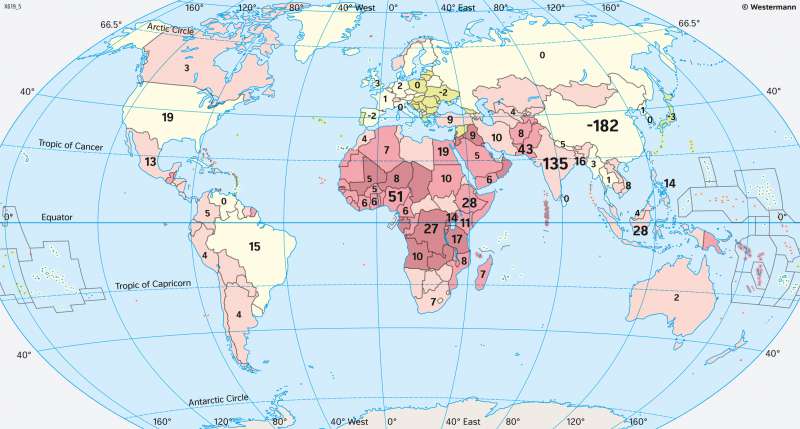The World - Demographic development
Population
978-3-14-100890-6 | Page 36 | Ill. 3

Overview
The world map provides an overview of the varying intensity of population growth in the different states and regions of the world. The data (changes in percent) is represented by colours and completed by numbers with absolute data. The latter show that absolute population growth is concentrated in only a few large countries, especially in Asia and Africa (Firstly, India, then China, Nigeria, Pakistan, and Indonesia). Especially due to immigration, the USA occupies a special position, ranking 8th.
Industrialised and developing countries in contrast
The discrepancy between the industrialised countries with only low or even negative population growth on the one hand and many developing countries, especially the Least Developed Countries, with high birth and death rates is striking.
In industrialised countries, birth and death rates are similar. For this reason, there is either only a small population growth or stagnation, and in some cases even a decline in the population. The latter applies to Japan (see 36.1), Germany, Eastern and South-Eastern Europe, among others, where the mortality rate has declined mainly due to improved medical care, but the birth rate is declining even more rapidly. In addition, in Eastern Europe there is considerable emigration from the potential parent generations to seek work, mainly in Western Europe. In some industrialised countries, for example Sweden and Australia, immigration has a stronger influence on population growth than natural population growth. There, a positive population trend can be observed.
In developing countries, on the other hand, where the number of births clearly exceeds the number of deaths, growth is relatively strong. The population there is young, above average, which can be deduced from the diagram for Africa, for example. The population trend shown for the developing countries is most clearly visible on the African continent (see 36.1, Nigeria).
Criticism
Increasingly, the demographic transition model is criticised - despite all its plausibility and clarity - and the demand is being made that, beyond economic factors, more recent social science research findings be incorporated. Examples include socio-cultural contexts, the heterogenisation of living spaces and political conditions in the industrialised countries.
Model of demographic transition
The demographic transition model, which is based on the interdependence between the level of development and the behaviour of a country's population, is often used to explain regional differences in population development. It should be noted that this model only depicts the course of a population development but says nothing about the length of time an individual state remains at a particular stage.
According to this model, pre-industrial society with fluctuating birth and death rates as a starting point is followed by a phase with a constantly high birth rate but rapidly falling death rate. This early transformative phase is caused by slight improvements concerning nutrition, health and hygiene in combination with a weak industrial development rate.
The subsequent transformative phase, also referred to as the phase of demographic transition, is characterised by a slight decline in birth rates and a further drop in death rates. Growing industrialisation causes a softening of the traditional pattern.
In the fourth phase, the late transformative phase, the demographic transition comes to an end. The final post-transformative phase, in which the modern industrial nations find themselves, is characterised by lower birth and death rates. It is accompanied by a high standard of living and strong social and economic security.
Criticism
Increasingly, the demographic transition model is criticised - despite all its plausibility and clarity - and the demand is being made that, beyond economic factors, more recent social science research findings be incorporated. Examples include socio-cultural contexts, the heterogenisation of living spaces and political conditions in the industrialised countries.




